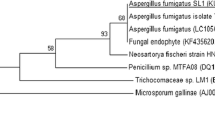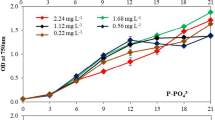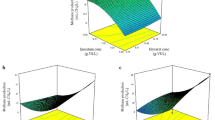Abstract
The components of a natural medium were optimized to produce cellulase from a marine Aspergillus niger under solid state fermentation conditions by response surface methodology. Eichhornia crassipes and natural seawater were used as a major substrate and a source of mineral salts, respectively. Mineral salts of natural seawater could increase cellulase production. Raw corn cob and raw rice straw showed a significant positive effect on cellulase production. The optimum natural medium consisted of 76.9 % E. crassipes (w/w), 8.9 % raw corn cob (w/w), 3.5 % raw rice straw (w/w), 10.7 % raw wheat bran (w/w), and natural seawater (2.33 times the weight of the dry substrates). Incubation for 96 h in the natural medium increased the biomass to the maximum. The cellulase production was 17.80 U/g the dry weight of substrates after incubation for 144 h. The natural medium avoided supplying chemicals and pretreating substrates. It is promising for future practical fermentation of environment-friendly producing cellulase.



Similar content being viewed by others
References
Adsul, M. G., Bastawde, K. B., Varma, A. J., & Gokhale, D. V. (2007). Strain improvement of Penicillium janthinellum NCIM 1171 for increased cellulase production. Bioresource Technology, 98, 1467–1473.
Kaur, J., Chadha, B. S., Kumar, B. A., & Saini, H. S. (2007). Purification and characterization of two endoglucanases from Melanocarpus sp. MTCC 3922. Bioresource Technology, 98, 74–81.
Berlin, A., Gilkes, N., Kilburn, D., Maximenko, V., Burra, R., Markov, A., Skomarovsky, A., Gusakov, A., Sintsyn, A., Okunev, O., Soiloveena, I., & Saddleri, J. (2006). Evaluation of cellulase preparation for hydrolysis of hardwood substrates. Applied Biochemistry and Biotechnology, 129, 528–545.
Herculano, N. P., Porto, S. T., Moreira, K. A., Pinto, G. A. S., Souza-Motta, C. M., & Porto, L. F. (2011). Cellulase production by Aspergillus japonicus URM5620 using waste from castor bean (Ricinus communis L.) under solid-state fermentation. Applied Biochemistry and Biotechnology, 165, 1057–1067.
Hsu, T. A. (1996). Pretreatment of biomass. In C. E. Wyman (Ed.), Handbook on bioethanol: Production and utilization (pp. 179–212). Washington: Taylor & Francis.
Alam, Z., Qudsieh, M. A. A., Muyibi, I. Y., Salleh, S. A., & Omar, H. M. N. M. (2009). Solid state bioconversion of oil palm empty fruit bunches for cellulase enzyme production using a rotary drum bioreactor. Biochemical Engineering Journal, 46, 61–64.
Singh, R., Kumar, R., Bishnoi, K., & Bishnoi, N. R. (2009). Optimization of synergistic parameters for thermostable cellulase activity of Apergillus heteromorphus using response surface methodology. Biochemical Engineering Journal, 48, 28–35.
Chu, J. J., Ding, Y., & Zhang, Q. (2006). Invasion and control of water hyacinth (Eichhornia crassipes) in China. Journal of Zhejiang University. Science. B, 7, 623–626.
Bo, M. J., Kong, X. F., & Yin, Y. L. (2009). Comparative study on nutritional ingredients and in vitro fermentation characteristics in various parts of water hyacinth, Natural production research and development. Nature Production Research and Development, 21, 40–45.
Goering, H. K., & Van Soest, P. J. (1970). Forage fiber analyses (apparatus, reagents, procedures and some applications). Washington: US Agricultural Research Service.
Wutzke, K. D., & Heine, W. A. (1985). A century of Kjeldahl nitrogen determination. Zeitschrift für Medizinische Laboratoriumsdiagnostik, 26, 383–388.
Xue, D. S., Chen, H. Y., Ren, Y. R., & Yao, S. J. (2012). Enhancing the activity and thermostability of thermostable β-glucosidase from a marine Aspergillus niger at high salinity. Process Biochemistry, 47, 606–611.
Adney, B., & Baker, J. (1996). Measurement of cellulase activities. LAP-006 NREL laboratory analytical procedure. Golden: National Renewable Energy Laboratory.
Miller, G. L. (1959). Use of dinitrosalicylic as reagent for the determination of reducing sugars. Analytical Chemistry, 31, 426–428.
Zheng, Z., & Shetty, K. (1998). Solid state production of beneficial fungi on apple processing wastes using glucosamine as the indicator of growth. Agriculture and Food Chemistry, 46, 83–87.
Aalbæk, T., Reeslev, M., Jensen, B., Susanne, H., & Eriksen, S. H. (2002). Acid protease and formation of multiple forms of glucoamylase in batch and continuous cultures of Aspergillus niger. Enzyme and Microbial Technology, 30, 410–415.
O’Donnell, D., Wang, L., Xu, J., Ridgway, D., Tingyue, G., & Moo-Young, M. (2001). Enhanced heterologous protein production in Aspergillus niger through pH control of extracellular protease activity. Biochemical Engineering Journal, 8, 187–193.
Hanif, A., Yasmeen, A., & Rajoka, M. I. (2004). Induction, production, repression, and de-repression of exoglucanase synthesis in Aspergillus niger. Bioresource Technology, 94, 311–319.
Suto, M., & Tomita, F. (2001). Induction and catabolite repression mechanisms of cellulase in fungi. Journal of Bioscience and Bioengeering, 92, 305–311.
Kang, S. W., Park, Y. S., Lee, J. S., Hong, S. I., & Kim, S. W. (2004). Production of cellulases and hemicellulases by Aspergillus niger KK2 from lignocellulosic. Biomass Bioresource Technology, 91, 153–156.
Trivedi, N., Gupta, V., Kumar, M., Kumari, P., Reddy, C. R. K., & Bhavanath, J. B. (2011). Solvent tolerant marine bacterium Bacillus aquimaris secreting organic solvent stable alkaline cellulase. Chemosphere, 83, 706–712.
Zhang, L., & Chi, Z. M. (2007). Screening and identification of a cellulase producing marine yeast and optimization of medium and cultivation conditions for cellulase production. Journal of Ocean University of China, 37, 101–108.
Gohel, V., Chaudhary, T., Vyas, P., & Chhatpar, H. S. (2006). Statistical screenings of medium components for the production of chitinase by the marine isolate Pantoea dispersa. Biochemical Engineering Journal, 28, 50–56.
Lo, C. M., Zhang, Q., Callow, N. V., & Ju, L. W. (2010). Cellulase production by continuous culture of Trichoderma reesei Rut C30 using acid hydrolysate prepared to retain more oligosaccharides for induction. Bioresource Technology, 101, 717–723.
Latifian, M., Hamidi-Esfahani, Z., & Mohsen Barzegar, M. (2007). Evaluation of culture conditions for cellulase production by two Trichoderma reesei mutants under solid-state fermentation conditions. Bioresource Technology, 98, 3634–3637.
Singhania, R. R., Sukumaran, R. K., & Pandey, A. (2007). Improved cellulase production by Trichoderma reesei RUT C30 under SSF through process. Applied Biochemistry and Biotechnology, 42, 60–70.
Liu, Y. T., Luo, Z. Y., Long, C. N., Wang, H. D., Long, M. N., & Hu, Z. (2011). Cellulase production in a new mutant strain of Penicillium decumbens ML-017 by solid state fermentation with rice bran. New Biotechnology, 98, 74–81.
Alama, M. Z., Mamuna, A. A., Qudsieha, I. Y., & Muyibi, S. A. (2009). Solid state bioconversion of oil palm empty fruit bunches for cellulase enzyme production using a rotary drum bioreactor. Biochemical Engineering Journal, 46, 61–64.
Xia, L. M., & Shen, X. L. (2004). High-yield cellulase production by Trichoderma reesei ZU-02 on corn cob residue. Bioresource Technology, 91, 259–262.
Author information
Authors and Affiliations
Corresponding author
Rights and permissions
About this article
Cite this article
Xue, DS., Chen, HY., Lin, DQ. et al. Optimization of a Natural Medium for Cellulase by a Marine Aspergillus niger Using Response Surface Methodology. Appl Biochem Biotechnol 167, 1963–1972 (2012). https://doi.org/10.1007/s12010-012-9734-4
Received:
Accepted:
Published:
Issue Date:
DOI: https://doi.org/10.1007/s12010-012-9734-4




